|
The
 News
News
Dedicated to Austrian-Hungarian Burgenland Family History |
THE BURGENLAND BUNCH NEWS - No. 295
February 28, 2019, © 2019 by The Burgenland Bunch
All rights reserved. Permission to copy excerpts granted if credit is provided.
Editor: Thomas Steichen (email: tj.steichen@comcast.net)
BB Home Page: the-burgenland-bunch.org
BB Newsletter Archives: BB Newsletter
BB Facebook Page: TheBurgenlandBunchOFFICIAL
Our 23rd year. The Burgenland Bunch Newsletter is issued monthly online.
The BB was founded in 1997 by Gerald Berghold, who died in August 2008.
|
Current Status Of The BB:
* Members: 2709 * Surname Entries: 8575 * Query Board Entries: 5750 * Staff Members: 15
|
NOTICE: Your Editor will be traveling in March so there will be either no newsletter or
only a reduced newsletter at the end of that month. Expect, though, a full newsletter at the end of April.
|
This newsletter concerns:
1) THE PRESIDENT'S CORNER
2) THE HIANZN (by Wilhelm Schmidt)
3) A SIMPLE REQUEST... A LESS THAN SIMPLE ANSWER
4) ONE RELATIVE? NO, FIVE GENERATIONS! (by David Hofer)
5) HISTORICAL BB NEWSLETTER ARTICLES:
- PASSAIC CO, NJ, DECLARATIONS / NATURALIZATIONS NOW ON-LINE
(by Margaret Kaiser)
6) ETHNIC EVENTS
7) BURGENLAND EMIGRANT OBITUARIES (courtesy of Bob Strauch)
|
1) THE PRESIDENT'S CORNER (by Tom Steichen)
 In
this month's collection of bits and pieces in Article 1, starts off with In
this month's collection of bits and pieces in Article 1, starts off with
Article 2, The Hianzn, by Wilhelm Schmidt, is one of a pair of related articles (the
other, titled "The Hianzisch Dialect", was published last month). In this second article, Wilhelm talks about the
people known as the Hianzn.
In Article 3, I've written up comments to A Simple Request... that turned into A Less Than
Simple Answer. I'm sure that many BB members have run into issues similar to those that complicated research into
the Burgenland family in this request. I hope my suggested approaches may be of some help to you also.
Article 4 is by our newest BB staff member, David Hofer, who joins the managing staff of the BB as
Surnames and Villages Editor. In his article, One Relative? No, Five Generations!, David tells about his
family research and introduces himself.
The remaining articles are our standard sections: Historical Newsletter Articles, and the Ethnic
Events and Emigrant Obituaries sections.

New BB Staff Member: I am pleased to announce that BB member David Hofer, of Alvarado, TX, has
volunteered to be our new Surnames and Villages Editor, replacing me in that role. David has been a BB member
since 2010, at which time he contributed houselists for Grafenschachen and Kroisegg. He has continued his research
into the Hofer surname, developing a large family tree.
David has kindly provided an autobiography to introduce himself; I present his words, One Relative? No, Five
Generations!, as Article 4 in this newsletter.
Please welcome David as the newest member of the BB staff!

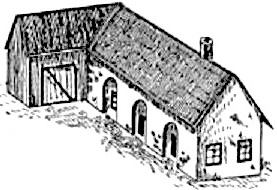 House Number
Translation Lists: I'm happy to report that the BB received a new house number translation list, this one for
Neusiedl bei Güssing. The list is a gift from Christian Ofenböck, now of Graz, Austria, but who grew up
in Neusiedl. Christian also gave lists for Kukmirn and Limbach, but we already had those. House Number
Translation Lists: I'm happy to report that the BB received a new house number translation list, this one for
Neusiedl bei Güssing. The list is a gift from Christian Ofenböck, now of Graz, Austria, but who grew up
in Neusiedl. Christian also gave lists for Kukmirn and Limbach, but we already had those.
As you may recall, for some years Burgenland has been transitioning from the old house number system to a modern street and
number format. The old house numbers were called Konskriptions-nummern (conscription numbers) and
the new numbers, which start over on each named street, are known as Orientierungs-nummern (orientation numbers).
The addition of Neusiedl raise the count of available house number translation lists to 59. Beyond that, 10 years ago, when
this project started, we had reason to believe that 92 villages would not be changing to the new system. Still, that left
164 villages that had already changed (136) or might change (28) and that we did not have translation lists for.
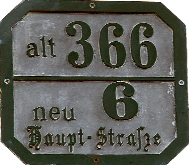 Thus we ask your help in
obtaining these lists. You can see on BB page
.../HouseNumberTranslation.htm which villages were known to need conversion lists (their names are shown in red).
Likewise, the ones in green were believed to have retained the old conscription numbers, while the ones in black were then
unknown; we have conversion lists for the ones with links. My expectation is that, eventually, almost all of Burgenland's
villages will convert to the new system, so we really need conversion lists for the remaining 256 villages. Thus we ask your help in
obtaining these lists. You can see on BB page
.../HouseNumberTranslation.htm which villages were known to need conversion lists (their names are shown in red).
Likewise, the ones in green were believed to have retained the old conscription numbers, while the ones in black were then
unknown; we have conversion lists for the ones with links. My expectation is that, eventually, almost all of Burgenland's
villages will convert to the new system, so we really need conversion lists for the remaining 256 villages.
Thus, if you have a list, please share; if you are in contact with relatives in Burgenland, ask if they can get and share a
list (the local municipal office should have one). If nothing else, ask them to confirm whether or not the village has
changed to the new system then share your answer with the BB. We'll take information any way we can get it!

Record Sets at Matricula Online: The following table documents the current availability of digital images of
vital record sets (matricula registers/books) for parishes in Austria, found at
data.matricula-online.eu/en/oesterreich/:
| Location |
Type |
# Parishes |
| Austria |
Lutheran Archive |
2 |
| Burgenland |
Eisenstadt RC Diocese |
2 |
| Kärnten |
Gurk RC Diocese |
328 |
| Niederösterreich (eastern) |
Vienna RC Archdiocese |
568 |
| Niederösterreich (western) |
St. Pölten RC Diocese |
410 |
| Niederösterreich |
Lutheran Diocese, A.B. |
1 |
| Oberösterreich |
Linz RC Diocese |
427 |
| Salzburg |
Salzburg RC Diocese |
137 |
| Steiermark |
Graz-Seckau RC Diocese |
363 |
| Tirol |
Salzburg RC Archdiocese
Innsbruck RC Diocese |
353 |
| Vorarlberg |
State Archive |
117 |
| Vienna |
Vienna RC Archdiocese |
568 |
| Vienna |
Lutheran Diocese, A.B. |
2 |
| Vienna |
Calvinist Church, H.B. |
1 |
For Burgenland, the two parishes currently available are:
Mönchhof vital records register images, 1683-1938:
http://data.matricula-online.eu/en/oesterreich/burgenland/moenchhof/
Kaisersteinbruch vital records register images, 1690-1827:
http://data.matricula-online.eu/en/oesterreich/burgenland/kaisersteinbruch/

Start of Construction of the S7 Rudersdorf Tunnel: Last month, a ceremonial ground-breaking was held for the
Rudersdorf Tunnel, a key link in the Fürstenfelder Schnellstraße, aka, the S7 Expressway, which will connect
southern Burgenland to eastern Styria and to the A2 Freeway (the Süd Autobahn) to Vienna.
Last year, after an almost twenty-year-long legal tug-of-war, construction of the expressway began. It will lead from the A2
at Riegersdorf (Styria) to the eastern Burgenland border with Hungary at Heiligenkreuz. The tunnel will be 2.8 kilometers
(1.75 miles) long, cost about 160 million euros, and will be the first highway tunnel built in Burgenland.
The immediate benefit from the tunnel will be to remove traffic problems from the Rudersdorf municipality, as the old B65
highway runs through the heart of Rudersdorf. The wider goal for the Expressway as a whole is economic: "It is also
important for the economy, because infrastructure is important for rural areas. We want that not all people have to move to
the city to find work, but to live here and work - and that is our contribution," said Transport Minister Norbert Hofer.

The Fürstenfelder Schnellstraße, the S7, has a length of 29 kilometers (18 miles). The West section
(in pink) extends from the A2 in Styria to Rudersdorf, where it passes through a 2.8 kilometer-long (1.75 mile) tunnel (in
red). The East section (in yellow) extends from the tunnel to the Hungarian border at Heiligenkreuz.
Construction of the tunnel will take about 23 months and is rather unique. Rather than going through a monolithic rock mass,
the tunnel will go through a series of comparatively loose rock masses. Excavators, not explosives, will be used to remove
rock and soil and support structures will be inserted as the excavation proceeds.
The main arguments against the expressway was a concern that the environment would be damaged by the construction and that
the presence of a "high-level road" would create an increasingly busy transit route for freight traffic between Styria and
Hungary. Nonetheless, Governor Hans Niessl said at the groundbreaking, "I worked for this project for 18 years,
witnessing demonstrations against it. I am very happy that this tunnel is being built here. This leads to a relief of the
population, it leads to a business location in Burgenland being upgraded. It also leads to more traffic safety, therefore I
was for it for 18 years."
Overall construction cost for the S7 is about 700 million euros, with a target of the end of 2023 for completion.

State Visit to Israel: Austrian President, Alexander Van der Bellen, took his first state visit to
Israel during the first week of February, arriving with a delegation of over 50 members. He was welcomed by his counterpart,
Israeli President Reuven Rivlin, as they reviewed an honor guard during the welcoming ceremony at the presidential
compound in Jerusalem on February 4, 2019. In addition, he visited the Yad Vashem Holocaust Memorial Museum, where he
laid a wreath at a ceremony in the Hall of Remembrance, and the Western Wall in Jerusalem’s Old City, as well
as participating in a formal tree planting ceremony at the Grove of Nations, where over 100 past and present leaders
from around the world have planted a tree as a symbol of friendship, peace and continuity.
Van der Bellen also met with Israeli Prime Minister Benjamin Netanyahu at the Prime Minister's Office in Jerusalem,
where a bilateral memo of understanding was signed on continued cooperation in science, culture and education, as was a
declaration of intent on future international cooperation regarding assistance to third world countries.
Of more interest to us Burgenländers, the President also met with Rabbi Yitzhak Ehrenfeld, the
grandson of the last rabbi of Mattersburg, Samuel Ehrenfeld, and with Meir Deutsch, who has written a number
of articles for the BB Newsletter. Van der Bellen presented Rabbi Ehrenfeld with a copy of the street sign of the lane in
Mattersburg named after his grandfather.
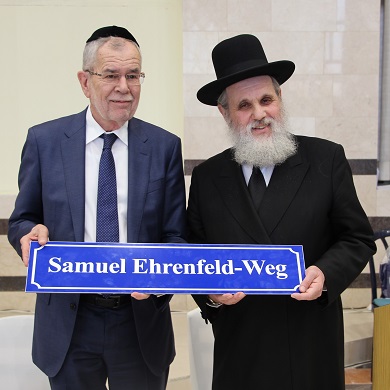
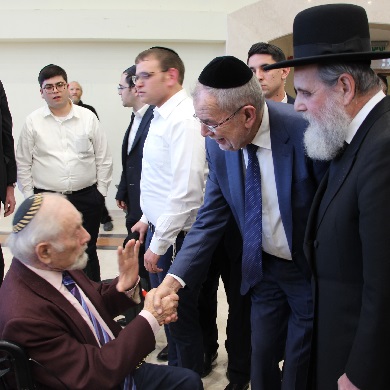
left: Austrian President Van der Bellen with Rabbi Yitzhak Ehrenfeld; right: with Meir Deutsch.
During the meeting with Meir Deutsch, Meir told the President that he could trace his family back into the 17th century
in Austria, and that two of his great-great-grandfathers were judges in Mattersdorf whose rulings can be found in the
Burgenland archives and in a book Meir wrote. Although the book is in Hebrew, President Van der Bellen requested an
inscribed copy.

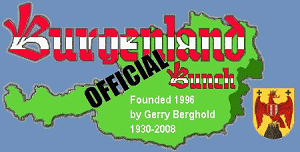 The
Facebook Bunch (from Vanessa Sandhu): The
Facebook Bunch (from Vanessa Sandhu):
Hello Burgenland Bunch!
Here is a little bit of what you might have missed if you haven't joined us on our Facebook group. We currently have
853 members. Since last month, 57 more members have joined us on Facebook. The group is always very helpful and
active. If you haven't joined us, please do!
www.facebook.com/groups/TheBurgenlandBunchOFFICIAL/
This month’s hot topic was a question posed by BB staff member Patrick Kovacs. We had a
great discussion about the online availability of FamilySearch’s 1828-1895 church records. He asked if members
managed to make full use of the records or if they didn’t bother, due to language barriers, lack of time or trouble
deciphering handwriting. The majority of respondents felt that the records were invaluable. Several posters felt that
visiting the Family Centers was not very convenient, and that the online availability was very helpful.
Another fun article was shared by Erin Eyroys Berghold. The article was about all blue-eyed people
sharing a single common ancestor. She asked how common blue eyes were in Austria. Many members chimed in to share the eye
colors that were prominent in their families. See
.../all-people-blue-eyes-have-common-ancestor
Mary E. Horvath was looking for a recipe for Spitzbuben and several of helpful members shared
their recipes.
Our members did lots of lookups and helped to decipher lots of tough handwriting, and our friend Werner
Schoenfeldinger shared a lovely song sung by the children of the kindergarten in Stadtschlaining. It is about
sledding in wintertime! Enjoy the song! https://youtu.be/DZNFBI886bU

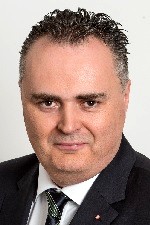 Burgenland
Government Changes: Last month, I mentioned that Burgenland Governor Hans Niessl retired after heading
the SPÖ party for 18 years, and that Hans Peter Doskozil was elected as the new party chairman. Doskozil
was scheduled to succeed Niessl as Burgenland's Governor on February 28th. Burgenland
Government Changes: Last month, I mentioned that Burgenland Governor Hans Niessl retired after heading
the SPÖ party for 18 years, and that Hans Peter Doskozil was elected as the new party chairman. Doskozil
was scheduled to succeed Niessl as Burgenland's Governor on February 28th.
That transition has taken place and the new state government leadership structure is now being defined. Deputy Governor,
Johann Tschürtz, and State Councilors Astrid Eisenkopf and
Alexander Petschnig retained their offices. New to the government leadership are Councilors Heinrich Dorner,
Daniela Winkler and Christian Illedits. Of the outgoing Councilors, Verena Dunst will be
the next State Parliament president, replacing Illedits, and Norbert Darabos, after 32 years in government, is
retiring to volunteer work, becoming president of the Friedenszentrums (Peace Center) Schlaining.
The planned responsibilities for these officeholders are:
| Office |
Officeholder |
Areas of Responsibility |
| Governor |
Hans Peter Doskozil |
Finances, Health, Culture and Administration |
| Deputy Governor |
Johann Tschürtz |
All Security Agendas |
| Councilor |
Astrid Eisenkopf |
Women, Environment, Energy, Conservation, Consumer Protection, Debt Counseling and Agriculture |
| Councilor |
Alexander Petschnig |
Economy and Tourism |
| Councilor |
Heinrich Dorner |
Construction, Spatial Planning, Transport and Housing Development |
| Councilor |
Daniela Winkler |
Education, Youth and Family |
| Councilor |
Christian Illedits |
Municipalities, Social Affairs,
Labor Market,
Sports and Europe |
Of the new government, only Councilors Eisenkopf and Petschnig have been part of prior Burgenland delegations that
visited emigrant enclaves in North America. Former Governor Niessl continued the tradition of these every-five-years visits,
sending delegations in 2002, 2007, 2012 and 2017 and personally participating in three... but will there be a 2022 visit?
We shall see.
As for Niessl, he responded in a December interview with DerStandard (a Vienna-based Austrian
newspaper), that he was completely retiring from politics and will open a consulting company in March or April.
When asked what accomplishments during his 18 years as governor he was most proud of, he said "I am proud of what
Burgenländers have achieved during this time. Today we have 30 percent more jobs in the country... we really took advantage
of the opportunity offered by the Objective 1 status with its funding. Second, the education system. From the land of school
shame, we have transformed ourselves into a modern, self-confident educational country. And third, we have a good health and
social system, which is not easy to organize for a rural area."
It is worth noting that Niessl's 18+ year reign as Governor (2000-2019) is the second longest in Burgenland history,
trailing only Theodor Kery's 21+ years from 1966 to 1987 and far exceeding the third-longest, 10+ years by Lorenz Karall
from 1946 to 1956. Not bad for a man who started as a primary and secondary school teacher in Frauenkirchen. Niessl's entry
into politics was as mayor of Frauenkirchen, which led to election as a member of the state parliament. He quickly became
chairman of his party, which led to the governorship. In 2005, he carried his party to a historic level of election success,
winning over 52 percent of the vote and the absolute majority of the parliament, levels extremely difficult to attain when
there are four major parties competing for votes. Yes, not bad!
Note: Letters have been sent on behalf of the Burgenland Bunch to both new Governor Doskozil and former
Governor Niessl, congratulating the first on his new role and inviting him to continue the Burgenland government delegation
visits to North America, and to the later for all he has done for Burgenland and its emigrant communities. If you should
wish to write, you can address your letters as follows:
Landeshauptmann [Hans Peter Doskozil or Hans Niessl]
Landhaus
7000 Eisenstadt, Burgenland, Austria

 Update
for book "The Burgenländer Emigration to America": Here is this month's update on purchases of the English issue of
the 3rd edition of Dr. Walter Dujmovits' book "Die Amerika-Wanderung Der Burgenländer." Update
for book "The Burgenländer Emigration to America": Here is this month's update on purchases of the English issue of
the 3rd edition of Dr. Walter Dujmovits' book "Die Amerika-Wanderung Der Burgenländer."
Current total sales are 1384 copies, as interested people purchased 11 more books during this past month.
As always, the book remains available for online purchase at a list price of $7.41
(which is the production charge for the book, as we purposely choose not to make a profit so we can avoid dealing
with the income tax consequences and so you can obtain the book at as low a cost as possible!), plus tax & shipping.
See the BB homepage for a link to the information / ordering page and for information
about current discounts (there is at least one discount on price or shipping available most of the time... if not, wait a
few days and there will be one!).

Burgenland Recipes: This month's recipe is from ongoing contributor Ed Malesky. An Internet search for
pictures of kipfels leaves room for your own interpretation; some look like mini jelly rolls, some like small
crescent rolls, some like almond crescent cookies, and some like kolachkys. The appearance isn't important; it's the
taste we're ultimately interested in, so use the design you like and enjoy.
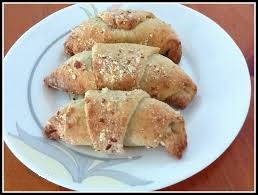 Kipfels
(from Ed Malesky) Kipfels
(from Ed Malesky)
Ingredients-dough:
1 lb. butter (room temp)
6 egg yolks
1/2 lemon, zest of
2 Tbsp sour cream
4 oz. semi-sweet white wine (e.g. Riesling)
6 cups flour
2 packages yeast
Ingredients-filling:
apricot jelly
Ingredients-other:
powdered sugar
beaten egg white (optional)
Preparation-dough (day 1):
Separate the egg yolks into a large mixing bowl and cream in the butter, lemon zest, sour cream, and half of the wine. Mix
flour and yeast then fold into the creamed ingredients. Knead the dough to mix well, adding more wine to moisten, if needed,
but the dough should not be sticky. Roll into 3-4 balls and refrigerate overnight.
Preparation (day 2):
Working one ball at a time, dust a table or breadboard with powdered sugar and roll out the dough to a thickness of 1/8" -
3/16". Cut into two- to three-inch squares, fill middle with apricot jelly and roll from corner or edge, then seal together
by pinching dough or with beaten egg white. Place the kipfels on a dry baking sheet and bake for 15 minutes at 350 degrees.
Serve with a dusting of powdered sugar (but don't store them that way long-term... the sugar absorbs moisture and makes them
soggy).
 
Note: We again have a "regular" source for Burgenland recipes.
Nonetheless, if you have a favorite family recipe, please consider sharing it with us. Our older relatives, sadly, aren't
with us forever, so don't allow your favorite ethnic dish to be lost to future generations.
You can send your recipe to BB Recipes Editor,
Alan Varga. Thanks!

Cartoon of the Month:

|
2) THE HIANZN (by Wilhelm Schmidt)
The Hianzn are nowadays better known as Burgenländer. But their constriction to the province of Burgenland is
an historical accident. Originally, they occupied a much larger area than that which was separated from Hungary and annexed
to Austria in 1922. In fact, they occupied all of the area east to the downward flow of the Danube, known as Transdanubia.
The distinguishing feature of these people is the peculiar German dialect they speak. But they are not named after
the dialect. The dialect long predates the name. This circumstance has not deterred historians from referring to the
Carolingian settlers of the area as the original Hianzn. Arguably, these settlers are the forbears of the Hianzn.
The name is perplexing. It provides no innate hint of its origin or meaning. Various explanations of it have, therefore,
been given. The most common is that it is derived from Heinz, the diminutive of Heinrich. The person alluded
to is Heinrich II, a count of Güssing who died in 1274. But this assertion is not only anachronistic, it is linguistically
untenable. In Hianzisch (as in Bavarian), the diphthong ei is changed to oa or ua, not
ia. Besides, the area that became Burgenland was not referred to as Heinzenland until 1919, when a secession from
Hungary was attempted by the German-speakers of the area during the time before Burgenland was officially created by the
Allies.
Two other derivations must be mentioned, one from hia(n)z (in German, jetzt, meaning now), the other
from the Hianzisch word hänseln (meaning trying to fool someone). Both derivations founder on phonetic
grounds. The word Hianzn is said by pressing the tongue to the roof of the mouth to pronounce the n;
hia(n)z is really pronounced hiaz, by flipping the tongue forward between the aspiration of the i and the
a, only simulating an n after them. In hänseln, the umlaut ä is said like a long e. (In
Hianzisch, it is the umlaut ü that is replaced by the diphthong ia.) In any case, the joke alluded to
in the derivation of Hianzn from hänseln was usually on the witless Hianzn.
Although the derivation of the word is uncertain, its designation is not. It is the name for the rural German-speaking
population of the region. When the name first appears in print, it refers to someone performing a servile function,
specifically, to a long-distance hauler (Lohnfuhrwerker) or to a maid. The inhabitants of the region
provided a multitude of services. They took produce (vegetables, fruit, wine), livestock (pigs, chickens, birds) and
products (baskets, linen) to the markets in Vienna and in Pressburg. Young people went "in's Ungarn" to assist in
harvesting.
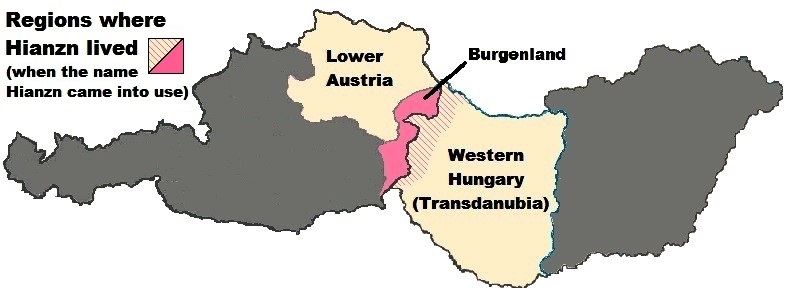
The designation of the Hianzn as the rural population marks them as locals. It is probably no coincidence that
the word Hianzn gains usage at the time the Donauschwaben came to Hungary in the 18th century. The
Donauschwaben were immigrants (Einwanderer). By contrast, the Hianzn had lived in the area already
for untold generations. The German word for the native-born is Hiesigen. Although there seems to be no exact
Hianzisch equivalent for this word, it could be Hianzign (those there already)—in slurred form,
Hianzn.
|
3) A SIMPLE REQUEST... A LESS THAN SIMPLE ANSWER
In a late-January New Member Information Form, we received a simple request, one much like many others that we have
received over the years... Karen Berge, of Langley, BC, Canada, indicated that her Graf ancestor from
Rauchwart settled in Halifax, Canada, in 1928. She further noted that the family was of the Catholic religion (which
is helpful in knowing which records to look in) and said she was "looking for information on the parents (Konrad and
Gizela Graf) and grandparents (Franz and Anna Graf) of my grandfather Gustav Graf born 17 Sept 1908 in Rauchwart (christened
in Sankt Michael church)." She further noted some related surnames: Eberhardt, Erkinger and Marx.
Given this information, it was quite easy to look up the birth record of Gustav, though being after 1895, it is found
in the Sankt Michael civil records (in the Güssing district), as it was recording location for Rauchwart. Doing so
verified that Konrad and Gizela were, indeed, parents of Gustav and revealed that Gizela's birth surname was Eberhardt
(so that explains one related surname). The birth record also gave the ages, 28 and 24, of Konrad and Gizela, their religion
(Catholic, as expected) and indicated that they were living in Rábort (Rauchwart) house number 130.
A quick look at the BB's HouseLists showed that the highest house number in Rauchwart in 1857 was 107, so #130 must
have been relatively new and was, thus, unlikely to be a long-term family home.
The most-obvious next step was, of course, to try to find the marriage record of Konrad and Gizela, as it should have
parents for both of them. Given Gizela was only 24 in 1908, it seemed probable that the earliest reasonable marriage year
was 1902, but 1904 was more likely. Going to the BB's FS Films (=FamilySearch.org Films) and finding Sankt
Michael in the Güssing district revealed that there were a lot of films for this recording location:
Side Note: If you look above, you should see that there are three major sections in the Sankt Michael
listing:
· the first section has the available Catholic (RC) records;
· the second section has the available Civil (GV) records; and
· the third section is an independent scan of the available Civil (GV) records.
The difference between the second and third sections is that the third section is from a direct digital scan of the
register books while the second section comes from a digital conversion of the earlier microfilm of the books. Thus
these two GV collections may differ slightly in arrangement, clarity and content.
There is also a wonderful little note in the Catholic records section, that being that "a transcription of these records
is located here:
SanktMichaelRecords." That note is a reference to a searchable/sortable database of Catholic church records for
Sankt Michael (Pusta Szent Mihály), consisting of 6,787 birth records, 1,355 marriage records, and 5,368 death records from
1828 to 1895. It is courtesy of BB member Margaret Roosdahl, who transcribed and shared them with us.
I'll say more about this database in a little bit but, as it won't help find a post-1895 marriage record, we have to
look elsewhere first.

Given the strong likelihood of a post-1903 marriage, I'll look in the GV Marriage collection for 1904-1920 (in the
first digitization), that being digital collection number 005036305. Sure enough, page 113 of that collection (see
here) has the 30
Apr 1904 marriage record for Konrad and Gizela, confirming the parentage for Konrad and adding lots of useful
information. As a generality, marriage records are an excellent way to leap between generations, as they usually give
information about both the bridal couple and about their parents.
In this case, we see that Konrad was born 17 Feb 1880 to Ferencz/Franz and Anna (Erkinger) Graf in Rábort (Rauchwart)
and that Gizela was born 17 May 1885 to Ferencz and Magdolna (Marx) Eberhardt, also from Rauchwart.
And, as the three italicized surnames in the above paragraph are the "related" ones that Karen had mentioned, it
seems evident that she had successfully followed the trail this far.

The next step is to see what more we can learn about Konrad and Gizela's parents... though,
alternatively, one could also spend some time in the post-1903 civil birth records to see if Konrad and Gizela
provided some siblings to Karen's grandfather, Gustav Graf. Regardless, we will move back a generation (as that is
the part of the research that I really want to talk about!).
Normally, that would mean looking first for the birth records for Konrad and Gizela (we have the dates from their marriage
record). We would do this to see if we can learn the ages and house numbers for their parents, as this should help find
their marriage records and give information that might be confirmed in those records. However, thanks to Margaret Roosdahl's
transcriptions of the Sankt Michael church records, we have a shortcut... we can quickly look for the marriages of the
parents, bypassing a step. We know the two parental pairs were married sometime around or before 1880 for the groom and 1885
for the bride.
Jumping to BB page
.../SanktMichaelRecords.htm and selecting Marriages, 1828-1895, the easiest thing to do is sort by either the
Husband or Wife (the default sort is by Date (of marriage), but it can be changed by clicking
another column header). Doing so by Husband and scrolling down to Eberhardt (Gizela's parents were Ferencz
and Magdolna [Marx] Eberhardt, which, when sorted alphabetically by husband, comes before the
groom's parents, Ferencz/Franz and Anna [Erkinger] Graf), we can see that three spellings of
that surname appear: Eberhardt, Eberhart, and Eberharth, but only version Eberharth has a
Ferencz (or Franz, Franciscus, etc.). Sure enough, on 23 Feb 1870, a surprisingly long time before
Gizela's birth (which is why it was useful to sort by Husband), there is the marriage of Franciscus Eberharth, age
30, and Magdalena Marksz, age 27. The spelling of her surname is odd but still phonetically correct, so I'm sure this is the
right couple.
Likewise, scrolling down to Graf, we see there are two surname spellings but only one with the right first name:
Franciscus Graf, age 24, married Anna Erkinger, age 20, on 28 Jan 1874. Almost certainly, this is the right couple too.
But here is where things become difficult... and why I wanted to write about this research: the marriage records do
not contain parental names, so making a firm link back another generation is suddenly uncertain! Unfortunately, this
is a common problem in earlier church records, as little information is provided in the records. Sure, the current
residences of the brides and grooms is provided in the 1870s marriage records ...but, go back to 1843-1854, the period of
birth for these people, and it is unlikely that even residence numbers are provided in the birth records. But let's check...
The marriage records show that all four individuals were living in Rauchwarth at the time of marriage, with house numbers
53, 51, 61 and 4. We'll now jump to the birth records, looking around 1840 for the birth of Franciscus Eberharth (he was 30
in Feb 1870, per his marriage record, so born 1839-1840... assuming the age is correct, that is). Unfortunately we do not
know his parental names. I'm going to do my search by using the default Date of birth/baptism order (not all records
have date of birth), going to February 1840, and searching back in time from there. I'll do the search using my browser's
search tool looking for text Eberhar in the Father column (which I hope will find all the variations of the
surname). Unfortunately, the search tool will find that text string in other columns too... but I'll just ignore those.
My first hit is for the birth of a Ferentz Eberharth on 29 Nov 1839 to Janos Eberharth and Anna Erdkhinig
of Rauchwarth (unfortunately, no house number given, as feared). This birth record is consistent with the expected
birth date, given the information in the marriage record... but are there more possibilities? Looking for Eberhar...
births before this one, I find no possibilities going back over three more years. Likewise, going forward three years from
the above birth, no possibilities there either. I also checked for illegitimate births for a Ferencz, Franz,
Franciscus, etc., in the right time period and found no possibilities (the easiest way to do that is to sort by
Father and then by (given) Name, as that will bunch together the records you want to consider). So it seems quite
possible we found the right birth record... though we must concede that Ferencz may have been born elsewhere.
So what do you do from here? One choice is to see if there are siblings to Ferentz; that is, other children born to the same
parents in a sensible surrounding time period. If so, finding the marriage records of the siblings and seeing the same house
number for one or more sibling in his/her marriage record as we found for Ferencz in his would be confirmatory evidence of
the correct parents, and therefore of the correct birth record. However, one must consider all possible spellings for
the parents' names... as Erdkhinig for the mother certainly seems like a nonstandard spelling! So is that the
correct name?
One choice is to go into the images of these church records and see if you would transcribe it the same way that the
compiler of these listings, Margaret Roosdahl, did. [In fact, and no offense to Margaret is involved here, you should
always look at the original record yourself!] Here it is...

Yep, I'd transcribe it as Erdkhinig too (note: that és above the surname is not an edit to it; rather it is
the Hungarian "and" that appears between parental names in all these records). Still, just because the surname was written
that way this time does not mean it was always spelled that way. Going through the birth records and pulling
possible other births for these parents (regardless of exact spelling of surnames) leads to this list:
|
Baptism |
Name |
Father |
Mother |
Witness 1 |
Witness 2 |
|
1839-11-29 |
Ferentz |
Eberharth, Janos |
Erdkhinig, Anna |
Hahot, Mihaly |
Paisl, Maria |
|
1842-01-03 |
Maria |
Eberharth, Janos |
Erdkhinig, Anna |
Vagner, Ferentz |
Hahot, Katalin |
|
1844-07-28 |
Istvan |
Eberhard, Janos |
Erkinger, Anna |
Paischl, Antal |
Hahut, Katalin |
|
1847-08-07 |
Theresia |
Eberharth, Janos |
Erdkinig, Anna |
Hahot, Mihaly |
Paisl, Maria |
|
1849-11-29 |
Josefa |
Eberharth, Janos |
Erdkinig, Anna |
Nerer, Josef |
Vagner, Anna |
|
1853-01-16 |
Josephus |
Eberhard, Joannes |
Erkinger, Anna |
Eberhard, Joannes |
Erkinger, Anna |
|
1854-12-31 |
Maria |
Eberhard, Joannes |
Erkinger, Anna |
Hirschbeck, Josephus |
Steiner, Maria |
These are the only reasonably possible births (that is, in an acceptable "birthing" time frame, adequate
gap between successive births, name spellings close enough, etc.). As you can see, the first and fourth
records are tied together by the matching witnesses, but the fourth record add a surname spelling variation for Anna:
Erdkinig. That spelling then ties us to the fifth record (as does, less strongly, the "Vagner" surname of
a witness). But look at records two and three... the second witness seems to be the same person... so is
Erkinger another, possibly more reasonable, spelling of Anna's surname? It is a spelling that goes forth into
more recent times (whereas the other two variations do not). If it is a reasonable variation then it raises the possibility
that the last two records are also for these same parents.
None of my comments above resolve the question of whether any or all of the above are siblings... but taking some of
these children forward to their marriage records may give some assurance of a relationship... that is, if house numbers
match or the more recent marriages also include parental names.
Unfortunately, this is the type of analysis that is needed if you wish to extend research back into this time period. It is
also why I titled this article, "A Simple Request... A Less Than Simple Answer." I won't run you through it, but the
same process could be used for the other three people in this family tree... and I suspect that similar, less than
satisfying, conclusions will be reached about potential parentages.
But here is the thing about this situation that really stinks... if you check the marriage records for the
marriage of the above parental pair, Janos Eberharth and Anna Erdkhinig, you'll find one on 2
Feb 1839. They were ages 24 and 20 ...and the parents are listed as Josef and Margita Eberharth and Marton and
Anna Erdkhinig! So not only do we remain unsure about this generation, we can't conclusively connect to a
well-documented additional generation!
Regardless, enjoy your research (it's the only research you have!).
|
4) ONE RELATIVE? NO, FIVE GENERATIONS! (by David Hofer)
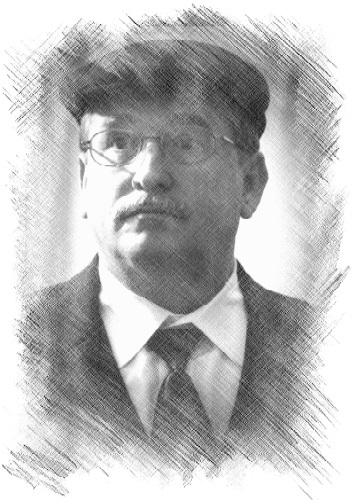 My
introduction to genealogy began in 1994 during a family trip to Chicago, where I was born. Oddly enough, nobody knew
anything about the Hofer family except that my father was the youngest of 16, that his parents had emigrated from
Europe, and that they were from a small German village named... uh, sounds like... grocery-shoppin'? My
introduction to genealogy began in 1994 during a family trip to Chicago, where I was born. Oddly enough, nobody knew
anything about the Hofer family except that my father was the youngest of 16, that his parents had emigrated from
Europe, and that they were from a small German village named... uh, sounds like... grocery-shoppin'?
Well, it wasn't until 2010 that my wife gave me the gift of DNA—maybe that would reveal something—it
did, but not any family connections. However, the DNA path led to the world of 'online genealogy.' Through dozens of
websites and months of research, a small golden nugget glimmered in the night: a ship record about my aunt, Emma Hofer
(age 14), visiting her father. This ship record listed the complete address of my grandparents in Chicago and Emma's
point of origin, a small village in Austria: Grafenschachen! (Emma was one of the three oldest children who stayed at
the family farm and cared for our grandparents... after which time, Emma moved to Chicago with the rest of the family.)
Other records listed the birth place of some Hofers as Arokszallas. Were we from Hungary? And was our name changed?
Hoefer, Hoffer and Höfer also appeared in the records. Nevertheless, Emma was one relative completely
researched. Next.
To shorten the story, all the pieces of the puzzle were coming together: Hungary vs. Austria?
Grafenschachen vs. Arokszallas? Austrian vs. Hungarian? ...and what about German?
Yes and Yes—the Burgenland Bunch made that clear: One relative found?
No, five generations! And Árokszállás is the Hungarian name of Grafenschachen, so Austrian and
Hungarian and Austro-Hungarian citizenship, plus German ethnicity!
While the Burgenland Bunch website did not have a Houselist for Grafenschachen (or Kroisegg) at that time, they had
enough information for me to research and create them. So early that fall I became a BB member and offered the Houselists
for those villages (see Newsletter #203, Sep 2010). Today, with the help of the BB
website, I have created not only a Hofer family tree of ten generations, but I am in the process of creating a "village
tree" of Grafenschachen—a complete structure of every family in the village. Why? Well...
that's another story.

David Hofer is a retired electronic engineer from Texas hoping to use his programming and engineering skills
to advance research in genealogy ...at the very least, to ease the research process of the BB membership. His last employer
was the US Patent Office. After their four children left home, he and his wife, Patty, rebuilt the family's
80-year-old homestead, where they pursue their interests like genealogy. Patty is a former Art and Latin teacher and
currently designs and creates quilts for Alzheimer's patients (called Fidget Quilts). Patty was also instrumental in
the translation of the many documents required for the Hofer family tree.
Research Surnames: Hofer, Kogler, Schutzenhofer, Luif, Kanitz, Hofstadter, plus 10 other distant relatives.
Research Villages: Grafenschachen, Kroisegg, Unterwaldbauern (ortsteile of Grafenschachen), Neustift an der
Lafnitz, plus Loipersdorf, Kitzladen, Kogl, Schwaben (ortsteile of Neustift an der Lafnitz).
Research Area of Study: 137 villages, 1347 surnames, plus 242 records for Hofer in 29 houses.
|
5) HISTORICAL BB NEWSLETTER ARTICLES
Editor: This is part of our series designed to recycle interesting articles from the BB Newsletters of 10 years
ago. For this month, I pull a submission from Margaret Kaiser, wherein she told us of a new free database. My expectation
was that, like so many old links on the web, the link to this database would be broken ...and, even if not broken, access
would no longer be free. Happily, I was wrong on both counts!

THE BURGENLAND BUNCH NEWS - No. 184
February 28, 2009
PASSAIC CO, NJ, DECLARATIONS / NATURALIZATIONS NOW ON-LINE
(by Margaret Kaiser)
Many Burgenländers immigrated to Passaic County, New Jersey to work in the area's clothing mills and other factories, and in
time, as a result, the New Jersey Burgenländer Society was established in Passaic County. The BH&R (Burgenländers
Honored and Remembered) web site includes a formal photo taken in 1932 of this society's membership. Many of the 115
photographed members have been identified by name. (Refer to
BH&R/homelinks/nj_burgenlaender_society-1932.htm to view these Burgenland-immigrants.)
Recently, Passaic County naturalization and land property records were made available online. This is more than an index,
since the actual document images are viewable and printable. There is no cost to use this site and there is no registration
requirement. The web site is: http://records.passaiccountynj.org.
Some of the naturalization records include a photo of the applicant. Many of the naturalization files specify the
applicant's hometown. In some cases there are name spelling variations but, if you enter the first few letters of a name,
you'll received all names beginning with those letters.
[Editor: I played a bit with the search program, which also lets you search by country of origin for a given year.
Selecting Hungary and 1920, one of the records that appeared was for a John Tamweber, whose name sounded to me like it was
from Burgenland. Below is the Declaration image:
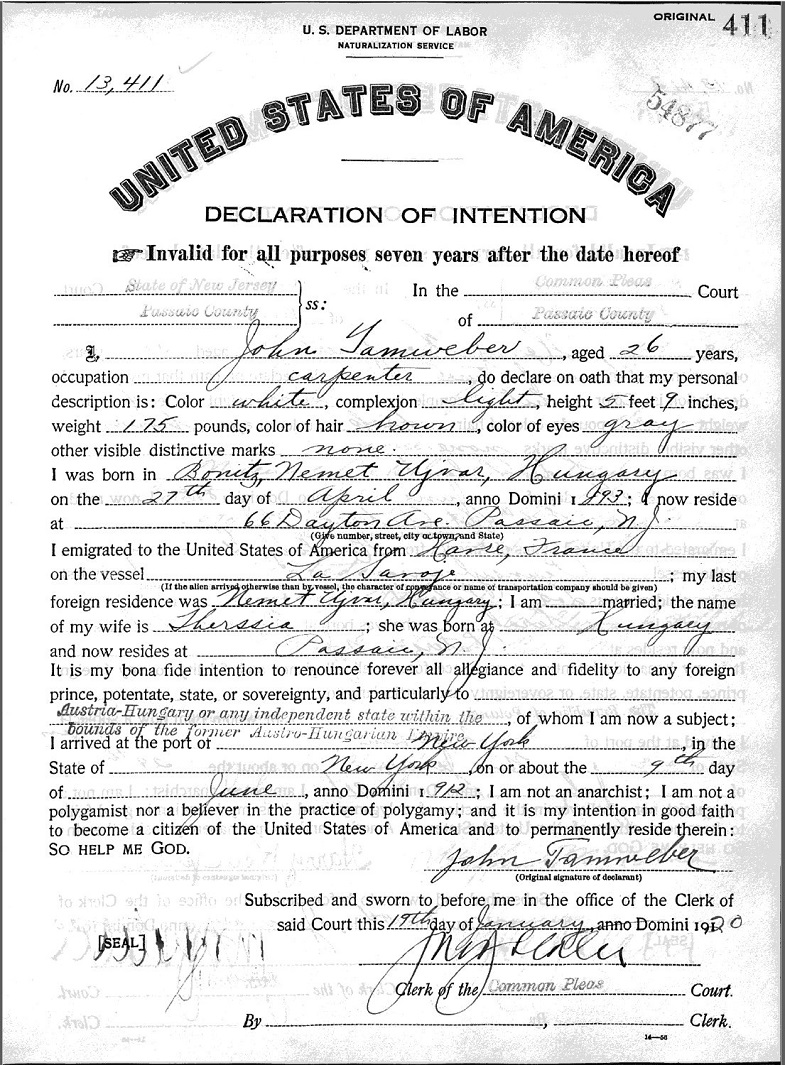
As you can see, John Tamweber was, indeed, from Burgenland, indicating he was born at "Bonitz, Nemet Ujvar, Hungary"
(a common phonetic/Hungarian version of Punitz in the Güssing district) on 27 Apr 1893. There is also information about his
wife and about his emigration to the US. So, if you have emigrant ancestors from Passaic County, do check out the
database.]
The BH&R is being updated to reflect now-known hometowns of the NJ Honorees. If you have any Burgenland ancestors to add to
the BH&R Honoree List from NJ or elsewhere, please submit them.
Good luck finding your ancestors with this additional search tool.
|
6) ETHNIC EVENTS
LEHIGH VALLEY, PA
Saturday, March 2: Fasching at the Evergreen Heimatbund in Fleetwood. Music by Maria & John. Info:
www.evergreenclub.org
Saturday, March 2: Fasching at the Reading Liederkranz. Music by the Josef Kroboth Orchestra. Info:
www.readingliederkranz.com
Saturday, March 2: Lumpenball at the Lancaster Liederkranz. Music by Die Mädeljäger. Info:
www.lancasterliederkranz.com
Sunday, March 3: Fasching at the Coplay Sängerbund. Music by the Emil Schanta Band. Info:
www.coplaysaengerbund.com
Saturday, March 16: Bockbierfest at the Lancaster Liederkranz. Music by Heidi & Heimatecho. Info:
www.lancasterliederkranz.com
Sunday, March 17: St. Patrick’s Dance at the Coplay Sängerbund. Entertainment by the Josef Kroboth
Orchestra and the O’Grady-Quinlan Irish Dancers. Info:
www.coplaysaengerbund.com
Sunday, March 24: Schlachtfest at the Holy Family Club in Nazareth. Music by the Josef Kroboth Orchestra.
Info: (610) 704-0803.
Saturday, March 30: Bockbierfest at the Reading Liederkranz. Entertainment by Live German Band and the
Edelweiss Schuhplattlers. Info: www.readingliederkranz.com
NEW BRITAIN, CT
Friday, March 1, 7 pm: Heimat Abend. Austrian Donau Club, 545 Arch Street, $3. Music by Frank
Billowitz.
Friday, March 15, 7:30 pm: Heurigan Abend. Austrian Donau Club, 545 Arch Street, $3. Music by
Schachtelgebirger Musikanten.
|
7) BURGENLAND EMIGRANT OBITUARIES
Johanna Neukum (née Leitner)

Johanna Neukum, 82, of Kinnelon, New Jersey, passed away suddenly at her home on January 31, 2019.
Born September 25, 1936 in Gaas, Austria, Johanna was the daughter of Julius and Susanna Leitner. She immigrated to the US
in 1958 and married Martin Neukum in 1961. The couple lived in Clifton before settling in Kinnelon in 1979.
Johanna worked at Balo Precision Parts in Butler, Johanson Electronics in Boonton, and Presto Lock, in Garfield. Johanna was
a gracious hostess and loved to entertain. She could easily throw together a party for 30 or more, making schnitzel, ham,
goulash. She was famed for her scrumptious vanilla kipferl, cream cheese cookies, butter gropfen, Linzer cookies, and
chocolate short bread logs, which were always a hit and loved by all. Johanna was a devoted parishioner of Our Lady of the
Magnificat Church in Kinnelon and will be remembered as a loving wife, mother and grandmother.
Johanna is survived by her children, Susan Fried and her husband Robert, Martin Neukum and his wife Maria, and Heidi LaRusso
and her husband David; her brother, Willi Leitner; and her grandchildren, Matthew, Ian, Kathryn, Lucas, Christian, Martin
and Suyin. Johanna was predeceased by her husband Martin, her brother Julius Leitner and her sister Hilda Kapeszki.
Visiting hours will be held on Monday from 2-4 & 7-9 pm on Monday, February 4 at Our Lady of the Magnificat Church,
Kinnelon. A funeral Mass will be celebrated 10 am on Tuesday at the church and burial will follow in the church cemetery.
www.scanlanfuneral.com.
|
END OF NEWSLETTER (Even good things must end!)
|
|
NOTICE (Informal Terms and Conditions): The Burgenland Bunch (BB) was formed and exists to assist Burgenland
descendants in their research into their heritage and, toward that end, reserves the right to use any communication you have
with us (email, letter, phone conversation, data upload, etc.) as part of our information exchange and educational research
efforts.
● If you do not want your communication to be used for this purpose, indicate that it is "confidential"
and we will attempt to abide by that request.
● Correspondents who communicate with the BB without requesting confidentiality retain their copyright
but give a non-exclusive license to the BB allowing us to forward to BB members, publish in our monthly newsletter or on our
website, and/or subsequently and permanently archive all or parts of such communications.
The formal Burgenland Bunch Website Usage Agreement can be found here: Agreement
The Burgenland Bunch homepage (website) can be found at: the-burgenland-bunch.org
Burgenland Bunch Newsletter, copyright © 2019 by The Burgenland Bunch
All rights reserved. Permission to copy excerpts granted if credit is provided. |
 In
this month's collection of bits and pieces in Article 1, starts off with
In
this month's collection of bits and pieces in Article 1, starts off with  House Number
Translation Lists: I'm happy to report that the BB received a new house number translation list, this one for
Neusiedl bei Güssing. The list is a gift from Christian Ofenböck, now of Graz, Austria, but who grew up
in Neusiedl. Christian also gave lists for Kukmirn and Limbach, but we already had those.
House Number
Translation Lists: I'm happy to report that the BB received a new house number translation list, this one for
Neusiedl bei Güssing. The list is a gift from Christian Ofenböck, now of Graz, Austria, but who grew up
in Neusiedl. Christian also gave lists for Kukmirn and Limbach, but we already had those. Thus we ask your help in
obtaining these lists. You can see on BB page
.../HouseNumberTranslation.htm which villages were known to need conversion lists (their names are shown in red).
Likewise, the ones in green were believed to have retained the old conscription numbers, while the ones in black were then
unknown; we have conversion lists for the ones with links. My expectation is that, eventually, almost all of Burgenland's
villages will convert to the new system, so we really need conversion lists for the remaining 256 villages.
Thus we ask your help in
obtaining these lists. You can see on BB page
.../HouseNumberTranslation.htm which villages were known to need conversion lists (their names are shown in red).
Likewise, the ones in green were believed to have retained the old conscription numbers, while the ones in black were then
unknown; we have conversion lists for the ones with links. My expectation is that, eventually, almost all of Burgenland's
villages will convert to the new system, so we really need conversion lists for the remaining 256 villages.
 My
introduction to genealogy began in 1994 during a family trip to Chicago, where I was born. Oddly enough, nobody knew
anything about the Hofer family except that my father was the youngest of 16, that his parents had emigrated from
Europe, and that they were from a small German village named... uh, sounds like... grocery-shoppin'?
My
introduction to genealogy began in 1994 during a family trip to Chicago, where I was born. Oddly enough, nobody knew
anything about the Hofer family except that my father was the youngest of 16, that his parents had emigrated from
Europe, and that they were from a small German village named... uh, sounds like... grocery-shoppin'? 

 News
News


 The
Facebook Bunch (from Vanessa Sandhu):
The
Facebook Bunch (from Vanessa Sandhu):  Burgenland
Government Changes: Last month, I mentioned that Burgenland Governor Hans Niessl retired after heading
the SPÖ party for 18 years, and that Hans Peter Doskozil was elected as the new party chairman. Doskozil
was scheduled to succeed Niessl as Burgenland's Governor on February 28th.
Burgenland
Government Changes: Last month, I mentioned that Burgenland Governor Hans Niessl retired after heading
the SPÖ party for 18 years, and that Hans Peter Doskozil was elected as the new party chairman. Doskozil
was scheduled to succeed Niessl as Burgenland's Governor on February 28th.  Update
for book "The Burgenländer Emigration to America": Here is this month's update on purchases of the English issue of
the 3rd edition of Dr. Walter Dujmovits' book "Die Amerika-Wanderung Der Burgenländer."
Update
for book "The Burgenländer Emigration to America": Here is this month's update on purchases of the English issue of
the 3rd edition of Dr. Walter Dujmovits' book "Die Amerika-Wanderung Der Burgenländer." Kipfels
(from Ed Malesky)
Kipfels
(from Ed Malesky)

